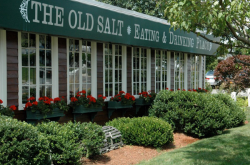Overview
NH’s premier live concert and comedy venue.
The Casino Ballroom at Hampton Beach is an up-close and personal venue with a long, illustrious history.
It began shortly before the 1900s, when Massachusetts businessman, Wallace D. Lovell, owner of the Exeter, Hampton and Amesbury Street Railway Company financed the construction of a two-story wood-frame building in the hopes that it would draw people to the Hampton Beach area and stimulate business. The building, which opened its doors on July 15, 1899, was christened the “Hampton Beach Casino.”
At that time, the word “casino” did not connote a gambling establishment as we understand it today. The word is Italian for “summer house” and came to describe a social gathering place, a room or building where one could dance, listen to music, and gamble. Lovell likely chose the term because, at the time, all things European were vogue in America. The name sounded exotic, and was familiar to thousands of immigrant workers in Lowell, Lawrence and Haverhill.
Though it is not yet classified as such, the Hampton Beach Casino is, to many, a historical landmark. It has been and will continue to be the heart of Hampton Beach. It has been the center attraction at one of New England’s most popular summer resorts for more than 100 years.
The Casino’s doors were first opened to the public on July 4, 1899. The top floor of the building contained sleeping rooms for employees as well as a suite of rooms made available to summer renters. The second floor was comprised of a large dancing and entertainment hall and also housed a spacious dining room, complete with a grand fireplace erected with sea stones and lined with seashells. The bottom floor, also containing a dining room and a cafe, boasted two bowling alleys, one billiard and two pool tables. The rear of tbe building was reserved for recreational activities, namely baseball and tennis. Just across the street, facing the Casino, was a kiosk of sorts for music entertainment such as bands and singers.
The facility expanded in 1900, with the construction of a 57-room hotel, the Ocean House, to the north of the Casino. The hotel, which was connected to the Casino by a bridge, advertised electricity and running hot and cold water in every room. In addition to the hotel, a two-and-a-half story convention hall was built at the Casino’s south end. One year later, construction of the Opera House was completed. The first floor housed 156 dressing rooms for local beachgoers. On the second floor was a large auditorium with a capacity of 700. Two hexagonal towers were added to the front corners of the casino, providing sightseers with a commanding view of the surrounding seacoast.
The Casino provided entertainment for the whole family. Vaudeville shows ran in the Opera House; a penny arcade, merry go-round, and shooting range, complete with live ammunition and clay pigeons were added below, on the street level. Baseball, now popular to many, was played frequently in the back to sizable crowds. Like most Atlantic resorts, the Casino flourished during the industrial revolution. Beginning in the first two weeks in July when the mills shut down, workers escaped their dark, ten-hour work days and streamed to the shore for sunlight and fresh air. Running on the new alternating current, the trolleys made the resort accessible to those near and far. The droves grew larger with the automobile’s advent, and by 1914, hundreds of Henry Ford’s inexpensive Model T’s were parked in front of the Casino.
Map
Visited 1264 times, 1 Visits today





 Previous Listing
Previous Listing